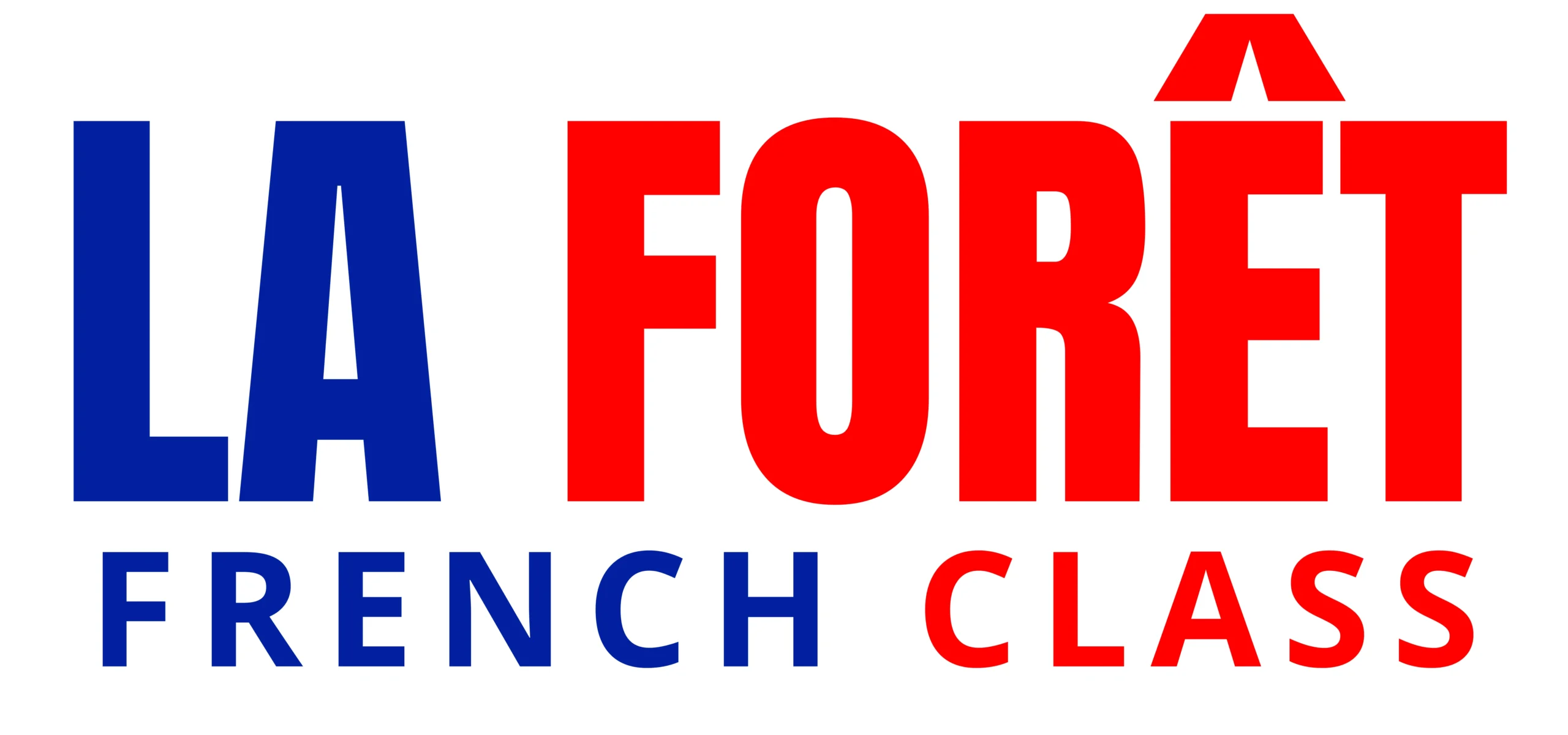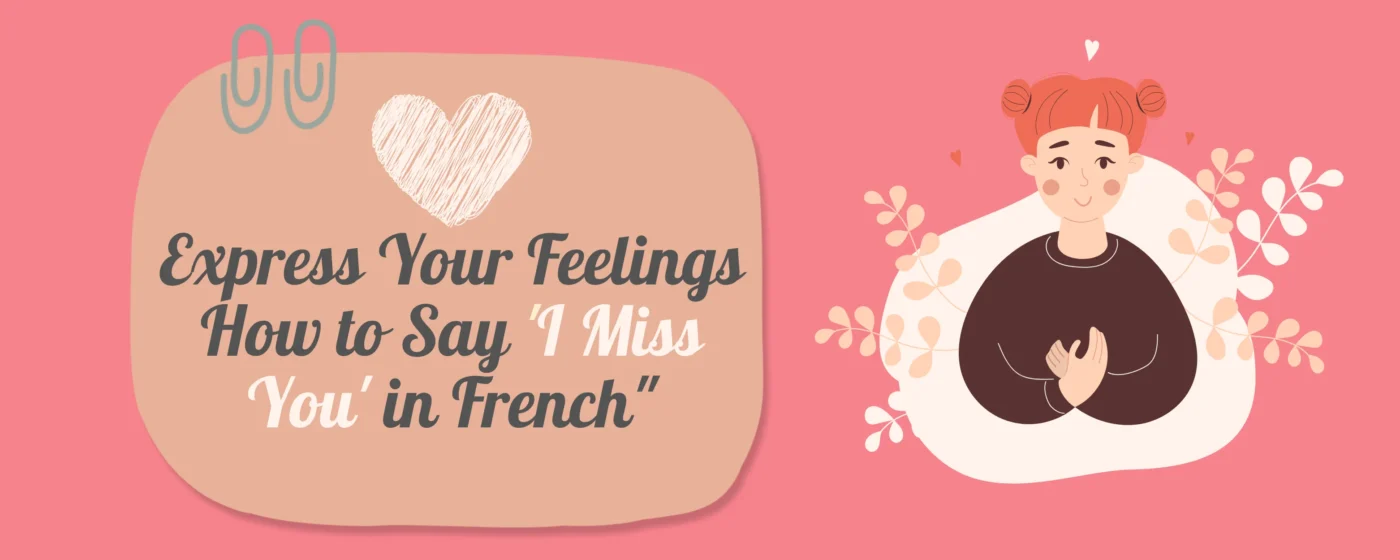Animals in French culture hold significant roles, from symbols in folklore to beloved pets. French language and literature frequently feature animals, reflecting their importance in daily life and national heritage. Whether in proverbs, children’s stories, or as national emblems, animals contribute to French cultural identity. Understanding their place in French society offers insights into the values and traditions that shape this vibrant culture.
Pets
Here are 10 common pets and their French translations:
| English | French | Pronunciation |
| Cat | Le chat | luh sha |
| Dog | Le chien | luh shee-ehn |
| Fish | Le poisson | luh pwah-sawn |
| Parakeets | Les perruches | lay peh-roosh |
| Rabbit | Le lapin | luh lah-pahn |
| Hamster | Le hamster | luh ahm-stehr |
| Guinea Pig | Le cochon d’Inde | luh koh-shohn dahnd |
| Turtle | La tortue | lah tor-tew |
| Snake | Le serpent | luh sehr-pahn |
| Parrot | Le perroquet | luh peh-roh-keh |


Enhance your French vocabulary with 50+ flower names in French to add a touch of elegance to your conversations and writings.
Farm Animals
Here are 10 farm animals with their French translations:
| English | French | Pronunciation |
| Cow | La vache | lah vahsh |
| Pig | Le cochon | luh koh-shon |
| Horse | Le cheval | luh shuh-val |
| Sheep | Le mouton | luh moo-ton |
| Chicken | Le poulet (or Le coq for a rooster) | luh poo-leh |
| Goat | La chèvre | lah sheh-vruh |
| Duck | Le canard | luh kah-nar |
| Turkey | La dinde | lah dand |
| Rabbit | Le lapin | luh lah-pan |
| Goose | L’oie | lwah |


Wild Animals
Here are 10 wild animals and their French translations:
| English | French | Pronunciation |
| Lion | Le lion | luh lee-on |
| Tiger | Le tigre | luh tee-gruh |
| Elephant | L’éléphant | lay-lay-fon |
| Giraffe | La girafe | la zhee-raf |
| Bear | L’ours | loors |
| Wolf | Le loup | luh loo |
| Deer | Le cerf | luh serf |
| Fox | Le renard | luh ruh-nar |
| Zebra | Le zèbre | luh zeb-ruh |
| Kangaroo | Le kangourou | luh kan-goo-roo |


Lost for Words? We’ve Got You!
Sign up for our courses and let our expert teachers boost your vocabulary effortlessly!
Water Animals
Here are 10 water animals and their French translations:
| English | French | Pronunciation |
| Fish | Le poisson | luh pwah-sohn |
| Dolphin | Le dauphin | luh doh-fan |
| Shark | Le requin | luh ruh-kan |
| Whale | La baleine | lah bah-len |
| Octopus | La pieuvre | lah pyuh-vruh |
| Crab | Le crabe | luh krahb |
| Sea Turtle | La tortue de mer | lah tor-tyu duh mehr |
| Seal | Le phoque | luh fok |
| Jellyfish | La méduse | lah may-dyooz |
| Lobster | Le homard | luh oh-mar |
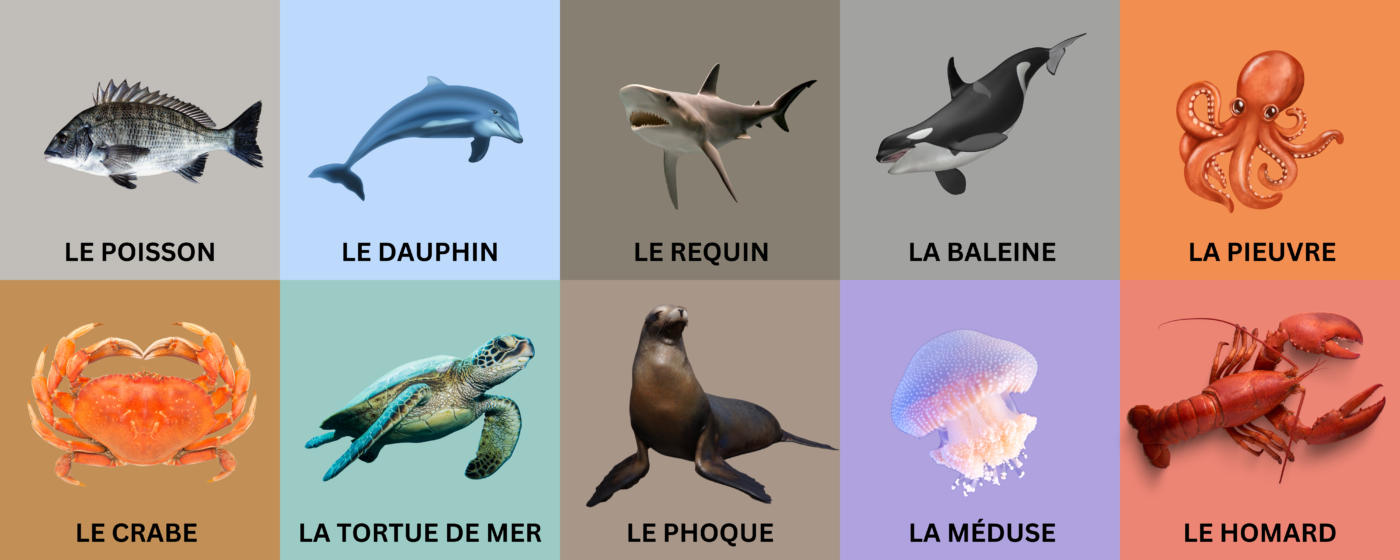

Bugs
Here are 10 bugs and their French translations:
| English | French | Pronunciation |
| Ant | La fourmi | lah for-mee |
| Bee | L’abeille | lah-bay |
| Butterfly | Le papillon | luh pah-pee-yohn |
| Spider | L’araignée | lah-ray-nay |
| Ladybug | La coccinelle | lah kok-see-nel |
| Mosquito | Le moustique | luh moo-steek |
| Fly | La mouche | lah moosh |
| Wasp | La guêpe | lah gep |
| Grasshopper | Le sauterelle | luh so-tuh-rel |
| Beetle | Le scarabée | luh ska-rah-bay |
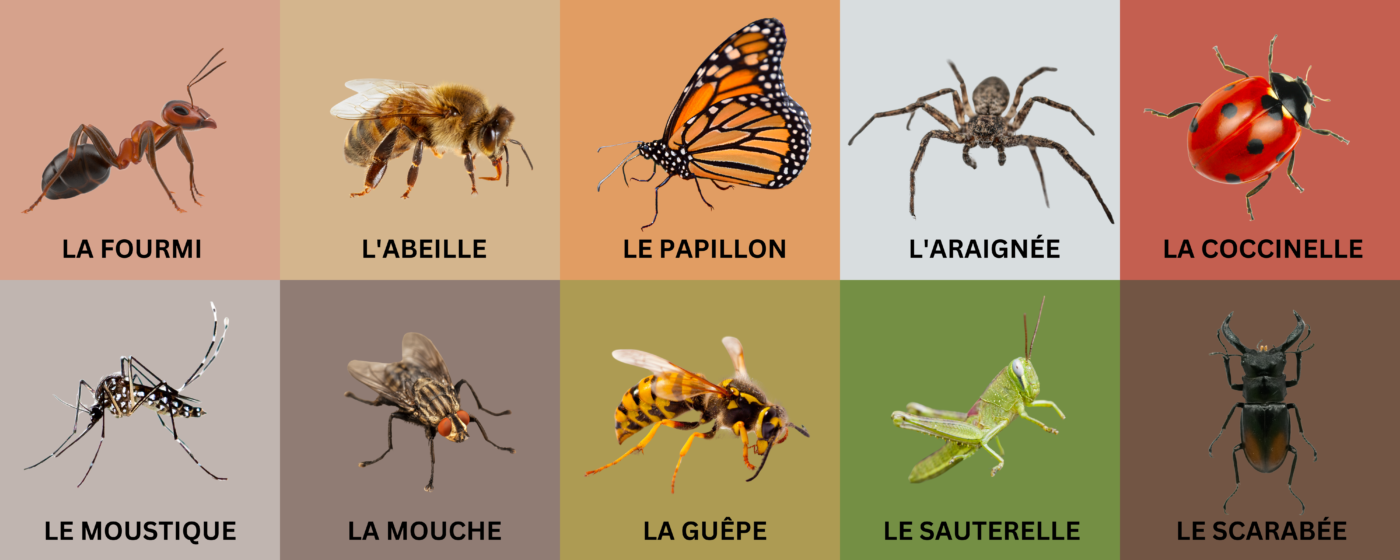

Birds
Here are 10 birds and their French translations:
| English | French | Pronunciation |
| Eagle | L’aigle | legl |
| Sparrow | Le moineau | luh mwah-no |
| Owl | Le hibou | luh ee-boo |
| Pigeon | Le pigeon | luh pee-zhon |
| Parrot | Le perroquet | luh peh-roh-kay |
| Crow | Le corbeau | luh kor-bo |
| Seagull | La mouette | lah moo-et |
| Peacock | Le paon | luh pah |
| Flamingo | Le flamant rose | luh flah-mon roze |
| Swallow | L’hirondelle | lee-ron-del |
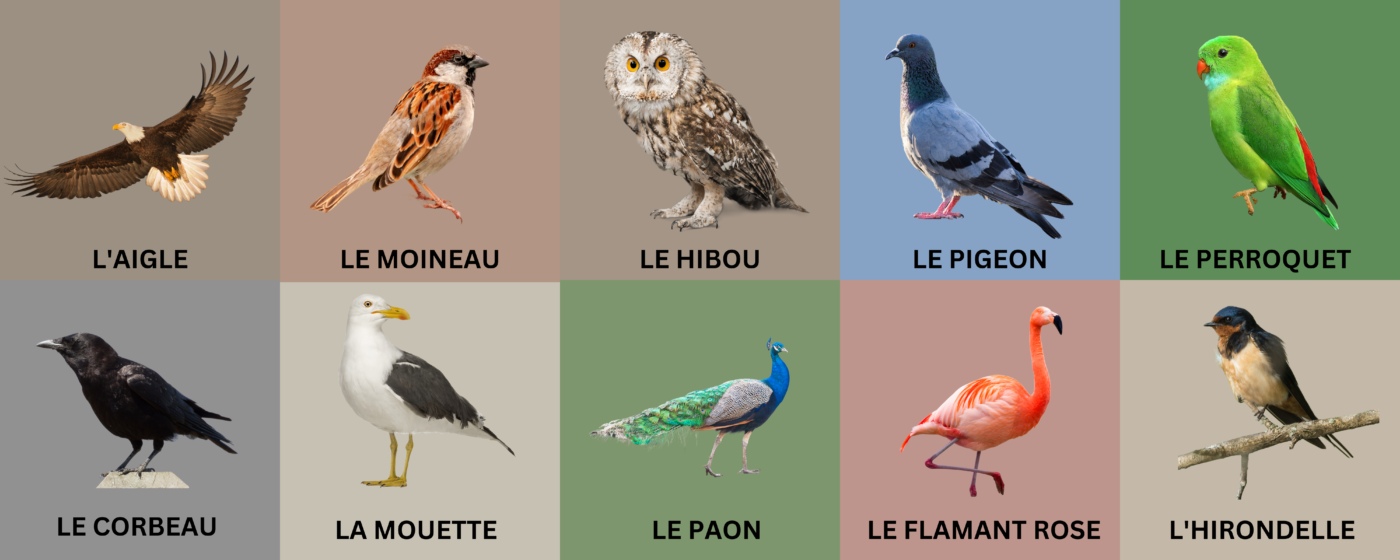

Expand your French vocabulary with this detailed list of 50+ bird names in French to enhance your language skills effortlessly.
Reptiles & Amphibians
Here are 10 reptiles and amphibians and their French translations:
| English | French | Pronunciation |
| Snake | Le serpent | luh ser-pahn |
| Lizard | Le lézard | luh lay-zar |
| Frog | La grenouille | lah gruh-noo-y |
| Toad | Le crapaud | luh krah-poh |
| Turtle | La tortue | lah tor-tyu |
| Crocodile | Le crocodile | luh kroh-ko-deel |
| Alligator | L’alligator | lah-lee-gah-tor |
| Chameleon | Le caméléon | luh kah-may-le-on |
| Salamander | La salamandre | lah sah-lah-mahn-druh |
| Gecko | Le gecko | luh geh-ko |


Animal/Birds Body Parts
Here are 10 body parts for animals in French, along with their English translations and an example phrase for each:
| English | French | Pronunciation | Example Sentence |
| Tail | La queue | /la kə/ | “Le chat agite sa queue.” (The cat is wagging its tail.) |
| Wing | L’aile | /lɛl/ | “L’oiseau déploie ses ailes.” (The bird spreads its wings.) |
| Paw | La patte | /la pat/ | “Le chien a une patte blessée.” (The dog has an injured paw.) |
| Beak | Le bec | /lə bɛk/ | “Le perroquet a un bec coloré.” (The parrot has a colorful beak.) |
| Fur | La fourrure | /la fuʁyʁ/ | “Le lapin a une fourrure douce.” (The rabbit has soft fur.) |
| Feather | La plume | /la plym/ | “Le paon montre ses plumes.” (The peacock shows its feathers.) |
| Claw | La griffe | /la gʁif/ | “Le lion a des griffes puissantes.” (The lion has powerful claws.) |
| Fin | La nageoire | /la naʒwaʁ/ | “Le requin a des nageoires.” (The shark has fins.) |
| Mane | La crinière | /la kʁinjɛʁ/ | “Le lion a une crinière majestueuse.” (The lion has a majestic mane.) |
| Snout | Le museau | /lə myzo/ | “Le cochon utilise son museau pour fouiller.” (The pig uses its snout to root around.) |
Animal Verbs
Here are some animal-related verbs in French with their English translations and example sentences:
| French Verb | English Translation | Example Sentence in French | English Translation |
| aboyer | to bark | Le chien aboie fort. | The dog is barking loudly. |
| miauler | to meow | Le chat miaule quand il a faim. | The cat meows when it’s hungry. |
| rugir | to roar | Le lion rugit dans la savane. | The lion roars in the savannah. |
| hennir | to neigh | Le cheval hennit joyeusement. | The horse neighs joyfully. |
| siffler | to whistle | L’oiseau siffle une mélodie. | The bird whistles a tune. |
| ronronner | to purr | Le chat ronronne sur mes genoux. | The cat purrs on my lap. |
| grogner | to growl | Le chien grogne en jouant. | The dog growls while playing. |
| gazouiller | to chirp | Les oiseaux gazouillent au lever du soleil. | The birds chirp at sunrise. |
| bondir | to leap | Le lapin bondit dans le jardin. | The rabbit leaps in the garden. |
| griffer | to scratch | Le chat griffe le canapé. | The cat scratches the sofa. |
Animal/Bird Idioms
Animal and bird idioms play a significant role in language and culture by reflecting common beliefs, values, and experiences. They create vivid imagery, making expressions more colorful and memorable. Universally resonant due to the familiarity of animals, these idioms often impart moral lessons, such as “The early bird catches the worm,” encouraging promptness.
They add humor and wit to conversations, describe character traits in relatable ways, and evoke emotional connections. Examples like “a fish out of water” for feeling out of place or “letting the cat out of the bag” for revealing a secret unintentionally demonstrate how these idioms enrich communication by drawing on the natural world.
Here are some French idiomatic expressions involving animals, their literal translations, meanings in English:
| French Idiom | Literal Translation | Meaning in English | Example Sentence |
| Avoir un chat dans la gorge | To have a cat in the throat | To have a frog in one’s throat (hoarse voice) | Ce matin, j’ai un chat dans la gorge et je peux à peine parler. |
| Poser un lapin | To put a rabbit | To stand someone up | Il m’a posé un lapin et je suis resté seul au restaurant. |
| Avoir une mémoire d’éléphant | To have an elephant’s memory | To have a very good memory | Elle a une mémoire d’éléphant, elle se souvient de tout. |
| Être comme un poisson dans l’eau | To be like a fish in water | To be very comfortable in a situation | Il est comme un poisson dans l’eau dans son nouveau travail. |
| Appeler un chat un chat | To call a cat a cat | To call a spade a spade | Il faut appeler un chat un chat et admettre nos erreurs. |
| Avoir d’autres chats à fouetter | To have other cats to whip | To have other fish to fry | Je ne peux pas m’occuper de cela maintenant, j’ai d’autres chats à fouetter. |
| Donner sa langue au chat | To give one’s tongue to the cat | To give up guessing | Je donne ma langue au chat, je ne trouve pas la réponse. |
| Être comme chien et chat | To be like dog and cat | To fight like cats and dogs | Ces deux-là sont toujours en train de se disputer, comme chien et chat. |
| Avoir une faim de loup | To have a wolf’s hunger | To be very hungry | Après cette randonnée, j’ai une faim de loup. |
| Chercher la petite bête | To look for the little beast | To nitpick | Arrête de chercher la petite bête et sois content du résultat. |
Conclusion
Animals play a significant role in French culture, from symbols in folklore to cherished pets. Their presence in language and literature reflects deep-rooted traditions and values. To further explore French vocabulary, visit our blog page for more insights.
Enhance your French language skills with essential Environment & Ecology Vocabulary in French to discuss sustainability and environmental topics fluently.
Did you know? The French term “cocorico” mimics a rooster’s crow and symbolizes national pride.
Frequently Asked Questions
Q: What is lion in French?
Ans: In French, a lion is called “lion,” pronounced as “lee-on.” This majestic animal often symbolizes courage and strength in French culture. To learn more about animal vocabulary and explore related topics, check out our blog.
Q: What are the top 3 pets in France?
Ans: The top three pets in France are cats (chats), dogs (chiens), and fish (poissons). These animals are beloved by many French households.
Q: What is a French bird called?
A bird in French is called “oiseau,” pronounced “wah-zo.” Birds play a prominent role in French nature and culture.
Q: What is a zoo called in French?
Ans: In French, a zoo is called “zoo,” pronounced “zoh.” Zoos are popular attractions in France, showcasing a variety of wildlife.
